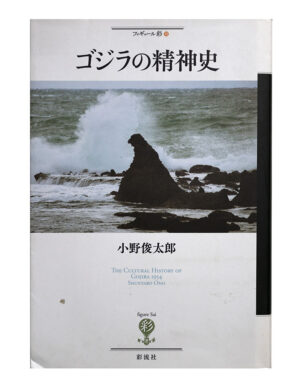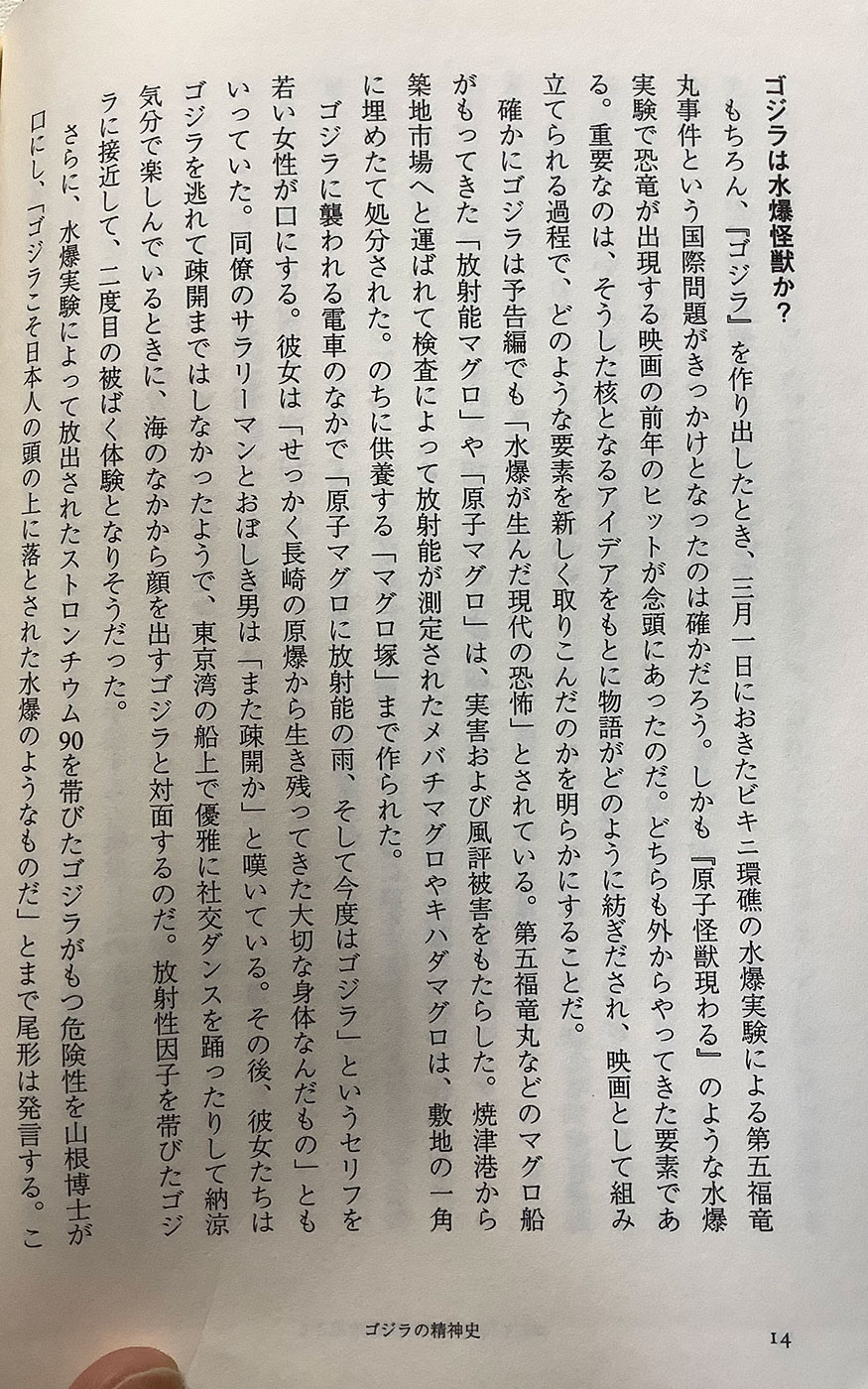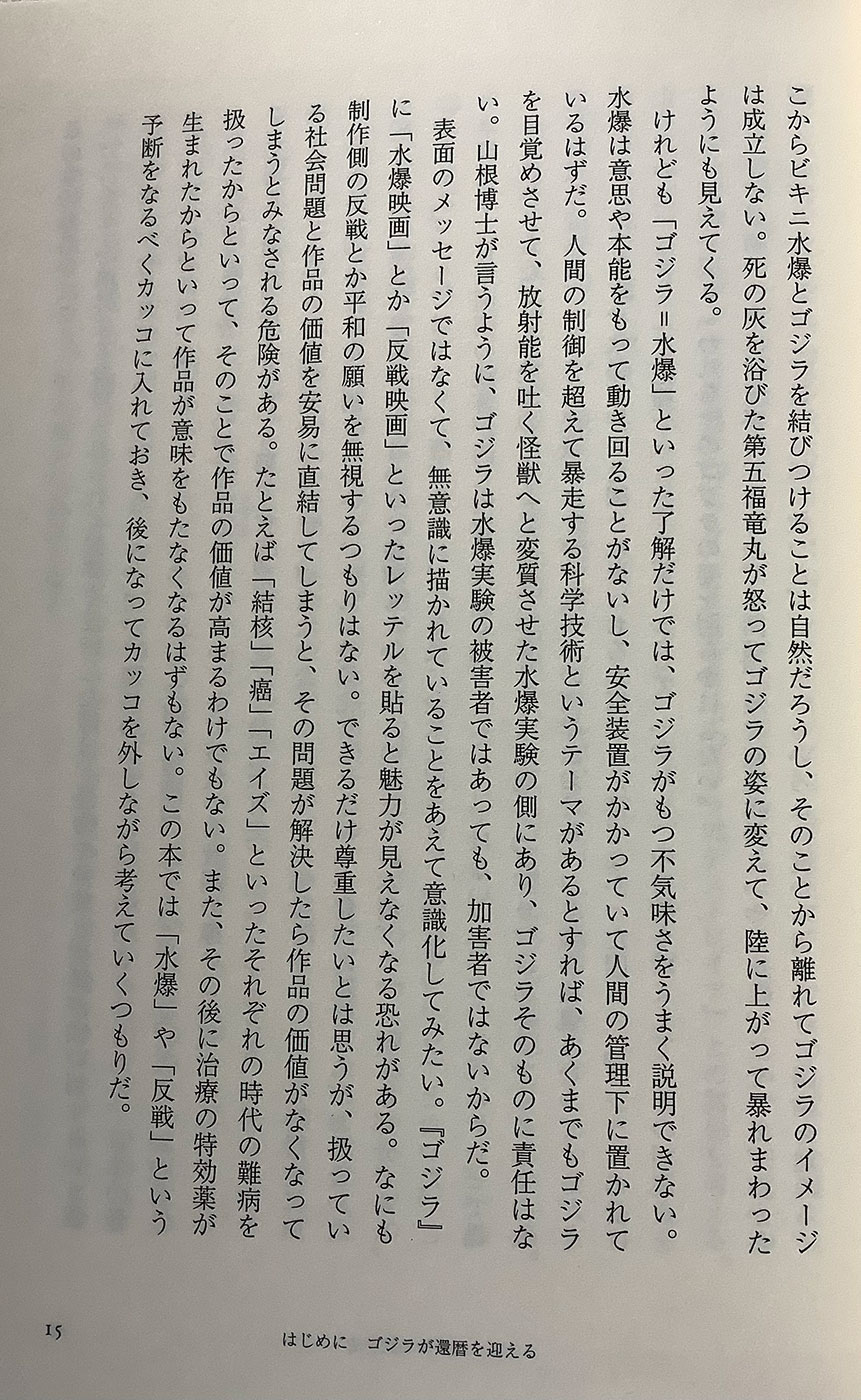9.12.2022
The Cultural History of Godzilla – Pt 5


P 14
ゴジラは水爆怪獣か?
Is Godzilla a hydrogen bomb monster?
もちろん、「ゴジラ」を作り出したとき、三月一日におきたビキニ環礁の水爆実験による第五福竜丸事件という国際問題がきっかけとなったのは確かだろう。しかも「原子怪獣現わる』のような水爆実験で恐竜が出現する映画の前年のヒットが念頭にあったのだ。どちらも外からやってきた要素である。重要なのは、そうした核となるアイデアをもとに物語がどのように紡ぎだされ、映画として組み立てられる過程で、どのような要素を新しく取りこんだのかを明らかにすることだ。
Of course, when “Godzilla” was created, the hydrogen bomb test at Bikini Atoll on March 1st, it is certain that the international issue of the Lucky Dragon No. 5 was the catalyst. What’s more, in mind were the previous year’s hit movies, such as “Atomic Monster Appears,” in which dinosaurs emerge from a hydrogen bomb test. It is to clarify how the story was spun and what new elements were incorporated in the process of assembling it as a movie.
確かにゴジラは予告編でも「水爆が生んだ現代の恐怖」とされている。第五福竜丸などのマグロ船がもってきた「放射能マグロ」や「原子マグロ」は、実害および風評被害をもたらした。焼津港から築地市場へと運ばれて検査によって放射能が測定されたメバチマグロやキハダマグロは、敷地の一角に埋めたて処分された。のちに供養する「マグロ塚」まで作られた。
Certainly, even in the trailer, Godzilla is described as “modern terror created by the hydrogen bomb.” “Radioactive tuna” and “atomic tuna” brought by tuna ships such as the Daigo Fukuryu Maru [Lucky Dragon No. 5] caused actual damage and reputational damage. Bigeye and yellowfin tuna that had been transported from Yaizu Port to Tsukiji Market and tested for radioactivity were buried in a corner of the site and disposed of. A “tuna mound” was even built to serve as a memorial service later.
ゴジラに襲われる電車のなかで「原子マグロに放射能の雨、そして今度はゴジラ」というセリフを若い女性が口にする。彼女は「せっかく長崎の原爆から生き残ってきた大切な身体なんだもの」ともいっていた。同僚のサラリーマンとおぼしき男は「また疎開か」と嘆いている。その後、彼女たちはゴジラを逃れて疎開まではしなかったようで、東京湾の船上で優雅に社交ダンスを踊ったりして納涼気分で楽しんでいるときに、海のなかから顔を出すゴジラと対面するのだ。放射性因子を帯びたゴジラに接近して、二度目の被ばく体験となりそうだった。
On the train being attacked by Godzilla, a young woman utters the line, “Atomic tuna, radioactive rain, and now Godzilla.” She also said, “It’s a precious body that survived the atomic bombing of Nagasaki.” Her colleague, a man who seems to be an office worker, laments that he has been evacuated again. After that, they escaped Godzilla and did not evacuate, when enjoying the cool breeze while dancing gracefully on a boat in Tokyo Bay, face-to-face with Godzilla emerging from the sea. Getting up close to Godzilla with a radioactive factor was likely to be her second exposure to radiation.

P 15
さらに、水爆実験によって放出されたストロンチウム9を帯びたゴジラがもつ危険性を山根博士が口にし、「ゴジラこそ日本人の頭の上に落とされた水爆のようなものだ」とまで尾形は発言する。ここからビキニ水爆とゴジラを結びつけることは自然だろうし、そのことから離れてゴジラのイメージ は成立しない。死の灰を浴びた第五福竜丸が怒ってゴジラの姿に変えて、陸に上がって暴れまわったようにも見えてくる。
In addition, Dr. Yamane mentioned the dangers of Godzilla, which was contaminated with strontium-9 released by the hydrogen bomb test, and Ogata even said, “Godzilla is like a hydrogen bomb dropped on the heads of Japanese people.” From here, it would be natural to link the Bikini Hydrogen Bomb with Godzilla, and apart from that, the image of Godzilla cannot be established. It looks as if Daigo Fukuryu Maru, bathed in the ashes of death, angrily changed into Godzilla and went on land to rampage.
けれども「ゴジラ=水爆」といった了解だけでは、ゴジラがもつ不気味さをうまく説明できない。 水爆は意思や本能をもって動き回ることがないし、安全装置がかかっていて人間の管理下に置かれているはずだ。人間の制御を超えて暴走する科学技術というテーマがあるとすれば、あくまでもゴジラ を目覚めさせて、放射能を吐く怪獣へと変質させた水爆実験の側にあり、ゴジラそのものに責任はない。山根博士が言うように、ゴジラは水爆実験の被害者ではあっても、加害者ではないからだ。
However, the understanding that “Godzilla = hydrogen bomb” alone cannot explain the eerie nature of Godzilla. H-bombs do not move around by will or instinct, and must be under human control with safeguards. If there is a theme of science and technology that goes beyond human control, it is the side of the hydrogen bomb test that awakened Godzilla and transformed it into a monster that spews radiation, and Godzilla itself is not responsible. As Dr. Yamane says, Godzilla was the victim of the hydrogen bomb test, but not the perpetrator.
表面のメッセージではなくて、無意識に描かれていることをあえて意識化してみたい。『ゴジラ』 に「水爆映画」とか「反戦映画」といったレッテルを貼ると魅力が見えなくなる恐れがある。なにも制作側の反戦とか平和の願いを無視するつもりはない。できるだけ尊重したいとは思うが、扱ってい社会問題と作品の価値を安易に直結してしまうと、その問題が解決したら作品の価値がなくなってしまうとみなされる危険がある。たとえば「結核」「癌」「エイズ」といったそれぞれの時代の難病を扱ったからといって、そのことで作品の価値が高まるわけでもない。また、その後に治療の特効薬が生まれたからといって作品が意味をもたなくなるはずもない。この本では「水爆」や「反戦」という予断をなるべくカッコに入れておき、後になってカッコを外しながら考えていくつもりだ。
I would like to be conscious of what is drawn unconsciously, rather than the superficial message. Labeling “Godzilla” as a “hydrogen bomb movie” or an “anti-war movie” may make it less appealing. I have no intention of ignoring the producers’ wishes for anti-war or peace. I would like to respect it as much as possible, but if the value of the work is easily directly linked to the social problem it deals with, there is a danger that the work will lose its value once the problem is resolved. For example, dealing with intractable diseases such as “tuberculosis,” “cancer,” and “AIDS” in each era does not increase the value of the work. Also, just because a miracle drug was born after that, it doesn’t mean that the work will lose its meaning. In this book, I put the preconceptions of “hydrogen bombs” and “anti-war” in parentheses as much as possible, and later I plan to think about them while removing the parentheses.